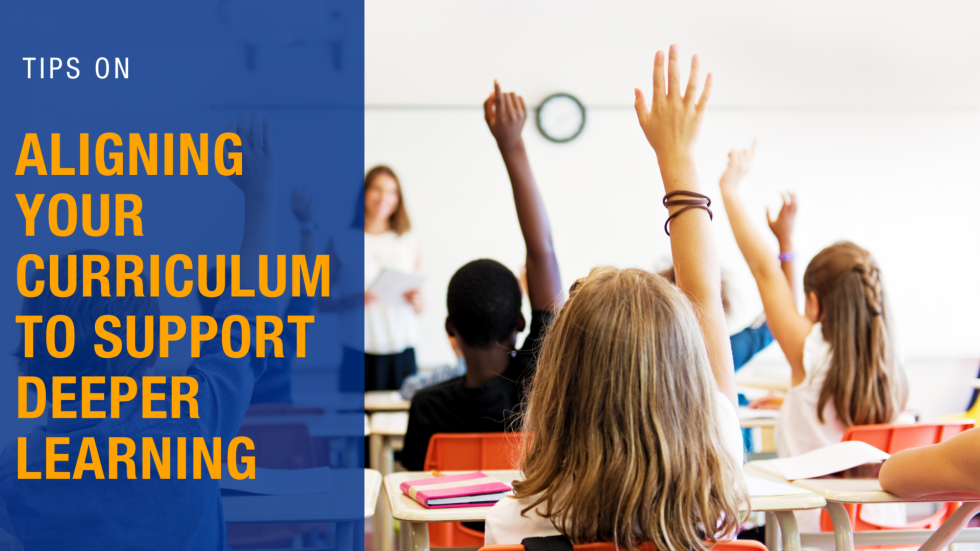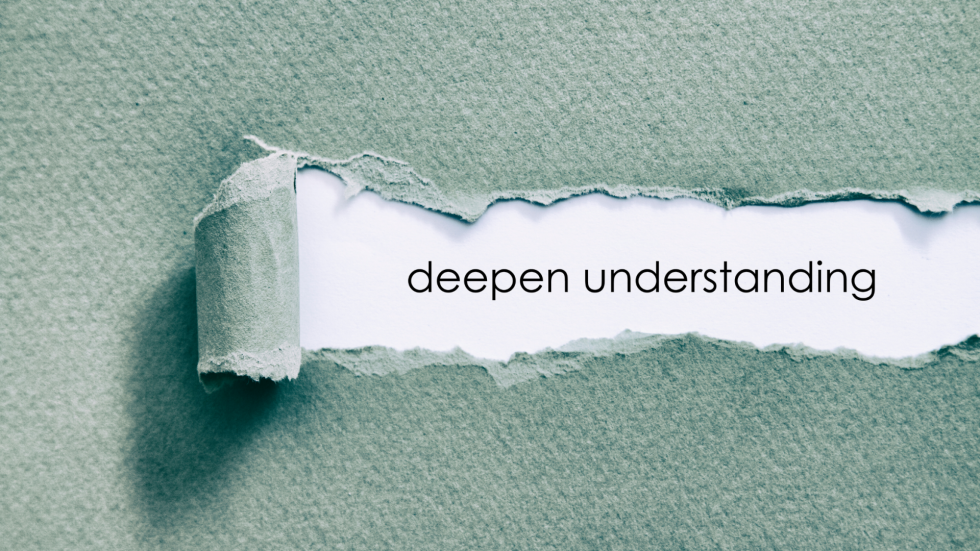Knowing Isn’t the Same as Understanding: Tips on Aligning Your Curriculum to Encourage Deeper Learning
Prefer to listen? Check out the audio recording of this post instead.
We all know there is a difference between knowing something and understanding it.
Knowing something helps us pass a test or quiz — the knowledge can be quickly discarded to make room for material for the next assessment.
Understanding a concept is different. When we understand something, we can take that knowledge and apply it to new situations. It’s not something that is forgotten the day after the test.
In our classes, we want students to do more than know the answer to a test. We want them to understand what we are teaching and how it applies to the class and the world, and we want them to be able to build on that knowledge as new concepts are introduced.
To achieve this goal, though, teachers must first align their instruction and assessment with the standards. This was the focus of SREB coaches Daniel Rock and Donn Kirkwood’s preconference presentation, “Aligning Assignments, Assessments and Instruction to Standards,” at the 2023 Making Schools Work Conference.
Set Learning Intentions With Success Criteria
When it comes to aligning your instruction and assessment with standards, one of the first things you can do is set your learning intentions to success criteria. Basically, if a learning intention establishes what a student will learn in the class, then the success criteria shows how the student will prove they learned it.
Here are some examples that were covered in the session:
Learning Intention: “I am learning to align curriculum, instruction and assessment so all students have opportunities to meet standards.”
Success Criteria: “I can develop assessments that are aligned to the standards and that measure student learning in a variety of ways.”
Learning Intention: “I am learning to analyze my curriculum for appropriate learning intentions and success criteria.”
Success Criteria:
- “I can identify the key concepts and skills that students need to master in order to meet the standards.”
- “I can write clear and concise learning intentions that state what students will be able to do by the end of a unit of study.”
Learning Intention: “I am learning to align instruction with the types of thinking required by standards.”
Success Criteria:
- “I can identify the types of thinking that students need to do in order to meet the standards.”
- “I can select instructional strategies that will help students develop these types of thinking.”
While these are the learning intentions and success criteria for the session itself, you can do the same thing for the goals you have in your classroom.
Big Ideas and Essential Questions
Once we established how to align intentions with success criteria, we began to discuss the importance of big ideas and essential questions.
Big Ideas
If you think back on your time in school, what do you remember learning? What stuck with you even after all of this time? The truth is that we all forget a lot of what we learned growing up, but we all have a few things that made a permanent dent in our brains.
These big ideas act as the center of a class, and curriculum experts Jay McTighe and Harvey Silver (2020) recommend that “…a modern curriculum be prioritized around a smaller number of conceptually larger, transferable ideas.”
There are several reasons for this:
- You can’t cover everything in school.
- Covering too much leads to disengaged students who temporarily “know” things without really learning them.
- Prioritizing large ideas fits today’s understanding of how students best retain information.
Think about the big ideas you want your students to come away with at the end of the semester – and then center your instruction and assessments around those concepts. To help with this process, Daniel and Donn recommended putting some of your keywords into an AI program like ChatGPT and asking it to tell you the big ideas it sees.
Essential Questions
Along with big ideas, your class should focus on the essential questions that will raise debate about these major concepts.
An essential question has many of the following criteria:
- It is open-ended (meaning it isn’t a yes or no question or one that has a “right” answer).
- It provokes discussion and deep thought.
- It calls for higher-order thinking that goes beyond basic recall of facts (such as analysis or inference).
- It places more emphasis on the “why” and the “how” than on the “what” of the concept.
- It helps establish important and transferable ideas that can be used throughout the discipline and maybe even across disciplines.
- It requires students to be able to support and justify the answer, instead of just answering the question.
- It can be revisited again and again.
To help think about your essential questions, look at the learning initiatives and success criteria you have created. What questions would help you move from the intention to the success model?
In the session, we got a handout with examples of essential questions in different subjects, which may also be useful to you.
Alignment and Teacher Clarity
Getting results from your curriculum is more than just creating learning intentions and figuring out what success would mean for each one. You really have to align everything if you want to see students start truly understanding the material.
According to the Carnegie Mellon Eberly Center for Teaching, you need to be able to align your assessments, objectives and instruction in order to really make an impact.
You may start by saying what you want students to learn (the objective), then you might determine the best way to measure that success (assessment), but there is a step in the middle:
What can you do (instruction) that gets students from A (the learning intention) to B (the success criteria)?
The lessons you create in class should be designed to be that bridge between these two steps.
Types of Thinking
As you work to align your objectives, instruction and assessments, you want to place a focus on moving students towards true understanding of the concepts. To do this, it’s good to change how you and your students think about the concept.
Here are some ways to start focusing on understanding:
- Ask essential questions like those discussed earlier in this post.
- Have students make connections between the material and things they already know and/or can relate to.
- Let students see the problem from multiple viewpoints.
- Focus more on interpretations and analysis of what is really happening in the lesson.
- Get students to see the evidence behind the claim.
- Look for the complexities in the concepts.
- Try to find the heart of the matter.
Here is a map of understanding that helps you visualize this process.
Aligning Strategies With Types of Thinking in Our Assignments
Now, ask yourself this: How often are you having students do the types of thinking reflected here in your classroom? Sometimes, it can be hard to prioritize these deep conversations in class because of everything else you are doing. In their session, Daniel and Donn discussed ways to help build understanding in a way that is aligned with standards.
To start, we talked about the way to divide the lesson: the pre-lesson, the lesson, the class discussion and the follow up.
Before Reading and Engaging With the New Content
Before students even start learning the new content, it’s a good idea to get them to start thinking about what they already know about this topic or related topics that might help them grasp the new material more easily.
This is also a good time help students do the following:
- Understand the purpose of the reading.
- Build curiosity about what they are going to learn.
- Make predictions about what they think they will be learning.
If you can get your students interested in the material and show them why this concept matters, they will go into the reading with an open mind.
During the Reading and Content Engagement
Along with pre-content lessons, you can also have students working on understanding as they read about or engage with the new concept.
Here are some ideas:
- Have them use context clues to find new vocabulary words.
- Get them to spot main ideas and important details.
- Have them create questions and summarize concepts as they read.
- Get them to state the inferred concepts within the text.
The Reading/Content Discussion and Student Discourse
Once students have read the material and/or you have covered it in class, you will likely create assignments designed to get them thinking about the new concept.
When you create these assignments, try to work in methods that get students thinking about the material and moving more towards understanding it. Here are some ways to do this:
- Have them use evidence to support a claim.
- Get them to explain the complex information they just engaged with.
- Work on revision and editing of the material they created based on updated knowledge.
- Have them conduct research on their own that gets them to deeper understanding.
Post-Lesson Reflection (Writing About the Content)
Once they have learned a new concept, it is good to have students write about what they learned. No matter the subject you teach, having these write-to-learn activities allows students a chance to put the concept in their own words and helps bridge their understanding.
This is also a good way to have students start forming thesis statements, create arguments and develop evidence-based claims.
Pulling It All Together
Moving a student from knowing something factually to understanding it fully can be hard. However, aligning your lessons to your goals and your success metrics makes it a lot easier.
Keep reading each week to get more tips like these and sign up for our Promising Practices Newsletter to get them delivered to your inbox each month.
Subscribe to Promising Practices






